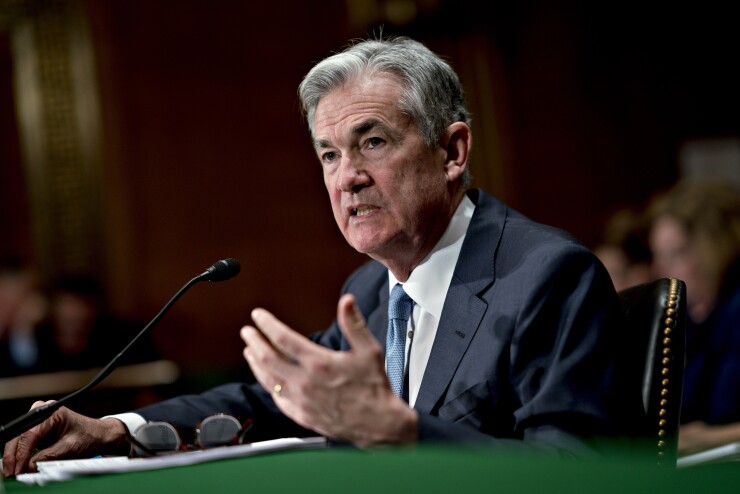The lender portal for the Federal Reserve’s Main Street Lending Program has opened as the long-awaited alternative to the problem-plagued Paycheck Protection Program after weeks of delays.
Unlike the PPP, which was created as part of the CARES Act to deliver forgivable loans to small businesses through the U.S. Small Business Administration as long as they retain their employees for eight weeks during the coronavirus pandemic, the Main Street Lending Program’s loans are not forgivable, although they are at low interest rates. The program is being offered through the Federal Reserve rather than the SBA and was originally aimed at large and midsize businesses. However, the Fed and the Treasury have been expanding the criteria. Last week, Federal Reserve chairman Jerome Powell announced that the minimum loan size would be lowered from $500,000 to $250,000, and the term of each loan option has increased from four years to five years.
"Supporting small and mid-sized businesses so they are ready to reopen and rehire workers will help foster a broad-based economic recovery," Powell (pictured) said in a statement. "I am confident the changes we are making will improve the ability of the Main Street Lending Program to support employment during this difficult period."

"The Committee has stated that we do not expect it will be appropriate to reduce the target range for the federal funds rate until we have gained greater confidence that inflation is moving sustainably toward 2%."
The Fed and the Treasury are also considering expanding the program to nonprofit organizations in addition to businesses. “Nonprofit organizations play a vital role in our economy and our society, and often are on the frontlines of our nation’s response to COVID-19,” said Treasury Secretary Steven Mnuchin in a statement Tuesday. “Many now face serious financial strains resulting from the disruptions to economic activity caused by the pandemic.”
The Main Street Lending Program could be helpful to accounting firm clients who have experienced frustration with the Paycheck Protection Program and its ever-changing rules, although it too has already undergone a number of changes since it was first announced, including expanded eligibility for smaller businesses.
“As one looks at the Main Street Lending Program, it’s an additional source of liquidity and borrowing,” said Phillip Austin, national assurance managing partner at BDO USA. “Obviously any company in the Main Street program would look at their source of funding and the conditions that come with it. There’s still money left in the Paycheck Protection Program and there’s money in the Main Street Lending Program. If I was in a company’s position, the questions I would ask would be the normal kind of questions one would ask: Do I qualify for the borrowings? Do I qualify for borrowings that could be forgivable? If I do and I’m comfortable with the conditions for those moneys which are in the PPP program or the health care support program, free money always counts ahead of repayable money. But if you’re not eligible for those programs or you look at the conditions of them, and you’d rather take the Main Street Lending Program, which comes with a repayment term and interest rate, then an entity would access those funds. The trickier part is, as history has worked out, there are funds available in multiple sources for any borrower. I would want to evaluate those sources of borrowing and work out what’s beneficial to their business.”
Andrew Gibson, BDO’s Global Employer Services national practice leader and the managing partner of BDO's National Tax Office, agrees that it’s important to be aware of the differences between the Paycheck Protection Program and the Main Street Lending Program, especially in terms of whether the loans are forgivable or not. “Certainly the way we view it from our perspective is if you qualify for the PPP loan, where you have to have 500 or less employees, obviously that’s optimal because it’s forgiven,” he said. “If you can get that, that would be preferable. Otherwise start looking at the other alternatives, like the Main Street Lending Program and the Title IV type approaches. You’ve got to analyze the conditions associated with each one of them and make sure you can live with the conditions. Certainly the rates are very favorable, and very borrower friendly, but they do come with conditions attached. You just need to make sure you’re aware of those as you make those decisions.”
According to the Federal Reserve, U.S. businesses may be eligible for loans under the Main Street Lending Program if they meet either of the following conditions: (1) the business has 15,000 employees or fewer; or (2) the business had 2019 revenues of $5 billion or less. Loans issued under the program have a five-year maturity, deferral of principal payments for two years, and deferral of interest payments for one year. The program will operate through three facilities: the Main Street New Loan Facility (MSNLF), the Main Street Priority Loan Facility (MSPLF), and the Main Street Expanded Loan Facility (MSELF). Eligible lenders can originate new loans under MSNLF and MSPLF, or increase the size of existing loans under MSELF that have been made to eligible businesses.
Austin pointed out that in the Fed’s
“When you think about that, a company might be able to access the Paycheck Protection Program, which doesn’t look first at the financial condition and creditworthiness assessment,” said Austin. “They may not meet the lending requirements of the Main Street Lending Program. ... If a lender has to apply underwriting standards in evaluating financial condition and creditworthiness, some companies will not meet the underwriting standards of that lender. This is a very different program. This is far more of a liquidity program, providing an additional source of funds under normal lending conditions, and less of a support program.”
So far, only the





